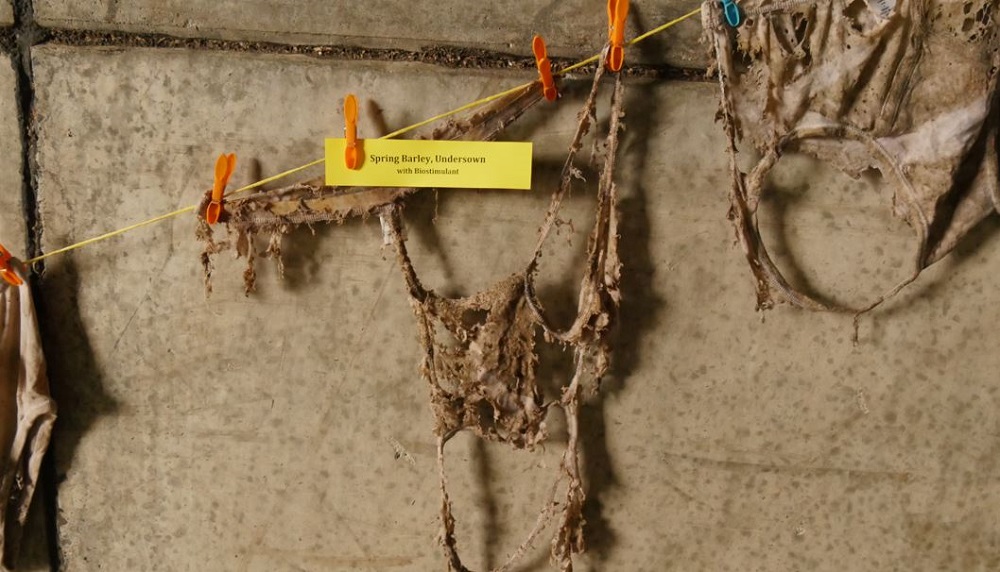AHDB outlines biostimulants basics for growers of cereals and oilseeds
Wednesday, 1 May 2024
Worth billions of dollars annually and continuing to expand, the global biostimulants market offers potential for growers. AHDB Environment Scientist Joanna McBurnie explores the product types, evidence of their benefits and usage considerations.
With rising input costs, fertiliser restriction pressures and extreme weather events becoming the ‘norm’, interest in biostimulants has piqued. Marketing material (for an expanding array of products) suggests that those who invest in biostimulants will see crop health, quality and, ultimately, yield increase. Potential benefits cited are often backed up with scientific-sounding words and claims, but can they be trusted and rise to the on-farm challenge?
Biostimulants basics
Regulation (EU) 2019/1009 defines plant biostimulants as any product that stimulates plant nutrition processes, independent of nutrient content. Their sole aim is to improve nutrient use efficiency, tolerance to environmental stress, quality traits or availability of confined nutrients in the soil or rooting zone (rhizosphere).
There are two broad groups of plant biostimulants: those based on non-living materials (non-microbial) and those containing living organisms (microbial or biological).
Non-microbial plant biostimulants include:
- Seaweed extracts
- Humic substances (extracted from decayed plants or animals, such as humic or fulvic acids)
- Phosphite and other inorganic salts
- Antitranspirants (such as abscisic acid and waxes)
- Chitin and chitosan derivatives (obtained from crustaceans)
- Protein hydrolysates (produced from animal and plant residues)
- Free amino acids (obtained through enzymatic breakdown of agro-industrial by-products)
Microbial biostimulants
This article focuses on microbial biostimulants. Based on organisms with a natural role in plant–soil interactions, these biological options may not be as unfamiliar as you might initially think.
Plant-growth-promoting bacteria and rhizobacteria
These bacteria are either found naturally on aerial parts of the plant or residing in plant roots and the rooting zone (rhizobacteria). They can foster mutually beneficial (symbiotic) relationships. For example, rhizobacteria, such as Rhizobium, are commonly found on the root nodules of legumes. Another example are free-living nitrogen-fixing bacteria, such as Azotobacter and Azospirillium.
Cited benefits include the stimulation of plant growth, through hormone interaction, improved assimilation of nutrients, including nitrogen (N), phosphorus (P), potassium (K) and micronutrients, and reduced damage from plant diseases. These benefits have been shown in principle on cereal crop species, although more UK field tests are needed to understand their full potential.
Mycorrhizae
This type includes arbuscular mycorrhizal (AM) fungi that associate with over 70% of land plants (excluding brassicas). The word ‘mycorrhiza’ stems from two Greek words: mykos and rhiza, which mean ‘fungus’ and ‘root’, respectively.
Through root colonisation, AM fungi form an extension of the root network, potentially helping to increase nutrient uptake, particularly P and, to some extent, N. The extended root network can also improve soil structure. These fungi have also been shown to increase crop tolerance to pests, pathogens and drought.
In the UK, field trials have shown mixed results. More consistent results could potentially be achieved through the long-term use of these biostimulants, giving them time to develop fungal networks.
Root-associated fungi
Root-associated fungi also interact with the plant in a positive way, but, unlike AM fungi, they do not need a host plant to survive. The various species occupy different plant areas. For example, Trichoderma species interact with root tissues, whereas Penicillium species interact with the root surface or the rooting zone (rhizosphere). Across the species, benefits include plant growth stimulation, improved P uptake (for example, Penicillium species can solubilise rock phosphate), protection against plant diseases, tolerance to environmental stress, and bio-remediation, via the sequestration of harmful substances.
Protozoa and nematodes
These common soil web organisms selectively graze bacteria and, to a lesser extent, fungi. They have been shown to increase the mineralisation of soil N and enhance root growth.
Mixes and complexes
Because of their biological nature, effective trialling and use of biostimulants is challenging. Most knowledge is also derived from tests of single components. However, many products on the market are based on mixtures of product types. There is very little robust information available on whether mixing product types is additive or synergistic. It is a key knowledge gap.
Selecting biostimulants
Make sure that a biostimulant is the right choice for your situation. For example, if your soils are in poor health, it may fail to support naturally present beneficial organisms, as well as any artificially added. The following saying holds true: “build it and they will come”.
The interactions between the site, the crop and the season are likely to be significant when using biostimulants. Consider trying a product in a relatively small area and compare it with the rest of the crop area (preferably over several seasons) to get a feel for whether it is right for your system.
It is also important to be clear about what you want to achieve. Define your goals and set your approach based on them. For example, if you want to manage large, accumulated soil P reserves, this will impact on the timing of your application.
Once you have selected a biostimulant, take time to get to know it. Follow all product guidelines to ensure the product is applied in good conditions.
Other things to consider
- Are the species native and proven in the UK?
- How could the biostimulant interact with native soil organisms?
- Is it incompatible with your system? For example, brassicas cannot form mycorrhizal associations
- Would the biostimulant benefit from the addition of a food source? For example, AM fungi need N and P to develop the initial relationships with compatible roots
- What formulations are available? For example, seed coatings may provide better access to plant roots at early developmental stages
- Do you need to assess the chemical status of your soil?
- What are the optimum moisture and temperature requirements? Microbial activity generally declines with temperature
- How could your fungicide programme affect biostimulant efficacy? For instance, fungal inoculants are unlikely to respond well to being tank mixed with certain fungicides
- How does soil management affect the biostimulant? For example, cultivations can damage mycorrhizal networks
- Does the rotation allow mycorrhizal networks to build? The network will deteriorate in the absence of host plants
- Do certain pests cause problems for the inoculant?
Evidence base
Most biostimulant tests have occurred outside of the UK, often tackling challenges such as drought, salinity, cold, alkalinity and limited nutrient levels.
If soils are in good health, many biostimulants are unlikely to contribute much on a day-to-day basis. However, where proven to be effective under UK field conditions (and cost-effective), they could warrant regular use to insure against ‘bad’ seasons.
Evidence for yield impacts associated with the use of biostimulants was reviewed for 11 broad product categories by ADAS/AHDB in 2016. As limited data was available for UK field conditions, evidence from controlled experiments and non-UK field conditions was also used.
The reviewers found that nine of the 11 product categories were associated with a statistically significant increase in yield in at least one experiment. For the most common product categories – seaweed extracts, humic substances, phosphite and plant-growth-promoting bacteria – statistically significant yield responses were observed for 3/7, 3/4, 4/17 and 13/15 cereal experiments, respectively. Data for oilseed rape was found to be lacking for all products, and no firm conclusions could be made.
Research
Can we harness the power of crop-friendly AM fungi?
Biostimulants and nitrogen management: an assessment of famer-led trials
Further information
Access in-depth information on biostimulants
Testing biostimulants at Monitor Farms
Biostimulates are often debated and tested on AHDB Monitor Farms.
 AHDB
AHDB
A monitor farmer (Morayshire Monitor Farm) recently buried boxer shorts (pictured) in the ground as a simple test of soil microbial activity (following application of a biostimulant). Another example of on-farm biostimulants tests is outlined in the case study (below).

Topics:
Sectors:
Tags:


